I’m in the weeds…..
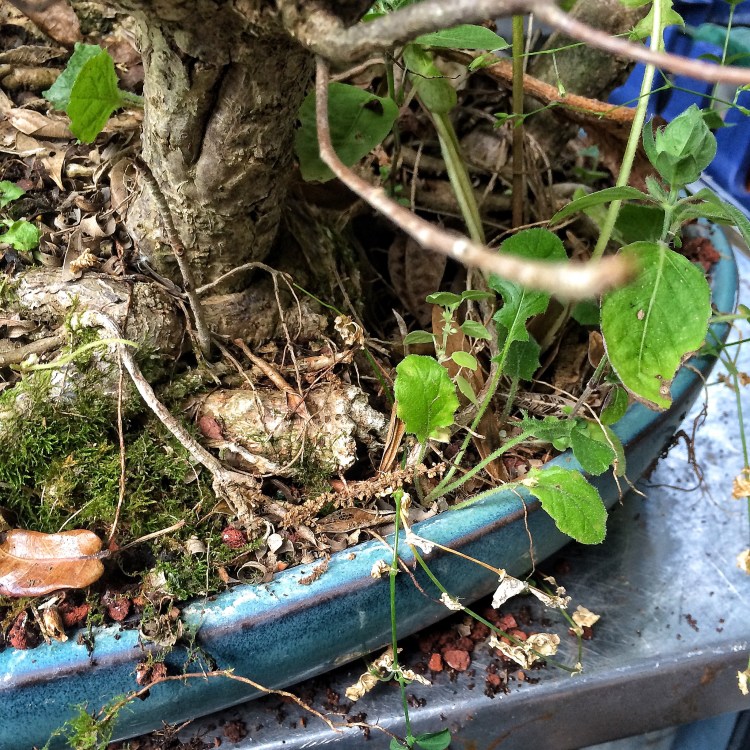 Literally. Let me finish up here and I’ll show you the tree.
Literally. Let me finish up here and I’ll show you the tree.
 What is that?
What is that?  A balloon. A yellow balloon. That reminds me of a poem I wrote as a lad:
A balloon. A yellow balloon. That reminds me of a poem I wrote as a lad:
A balloon, a balloon,
Yellow in hue,
It floats through the noon,
The bright yellow noon.
Forget the balloon,
It’s gone now, it’s flew
Remember it’s color.
It was yellow, not blue.
Hey, I didn’t say it was a good poem.
Anyway, here’s the tree.  Let me explain it’s history. It is an alumn of the BSF exhibit at the Epcot Flower and Garden show. At that time, it was a lot taller than it is now.
Let me explain it’s history. It is an alumn of the BSF exhibit at the Epcot Flower and Garden show. At that time, it was a lot taller than it is now.
After the show, it was cut back hard, and soon after that, I came into possession of it. I decided to let it grow out. Here is lesson one: sometimes, cutting a tree back hard and letting it grow out without training just doesn’t work.
I know that many bonsai teachers will tell you, almost by rote, that your tree needs to be chopped back and regrown. And it’s probably true in most cases. In this case, it was. But I should have been watching it and guiding its growth, not just letting it grow out.
Why, with this tree, should I have been more vigilant? Well, for one, it’s in a bonsai pot. That means bonsai soil. Which means more ramified growth, generally. Secondly, it’s a willow leaf ficus, which means that when you chop it, you don’t get just one new shoot at the top but 20, 30, maybe more. You really need to manage the growth. Which is is where I failed the test.
Sometimes, you’ll have nature manage the growth for you. In the summer, a salicaria almost always gets a fungus (here in Florida) that causes defoliation and dieback of the excess, weaker growth. It’s caused by the combination of the thick growth habit, afternoon thunderstorms, warm evenings and the natural occurrance of the “fungus among us”. You can do three things: 1) thin it out in July 2) apply a fungicide prophylacticaly, or 3) just let it happen. A salicaria can and does bounce back from the fungus easily.
I must have hit this clump accidentally with one of my preventative fungicidal sprays, it never thinned itself out naturally. 
To bastardize a Willie Nelson song “….it was the time of the scissor….” 
I need to get it out of the pot first, I’m sure I’m going to alter the front and I need to fix the roots.
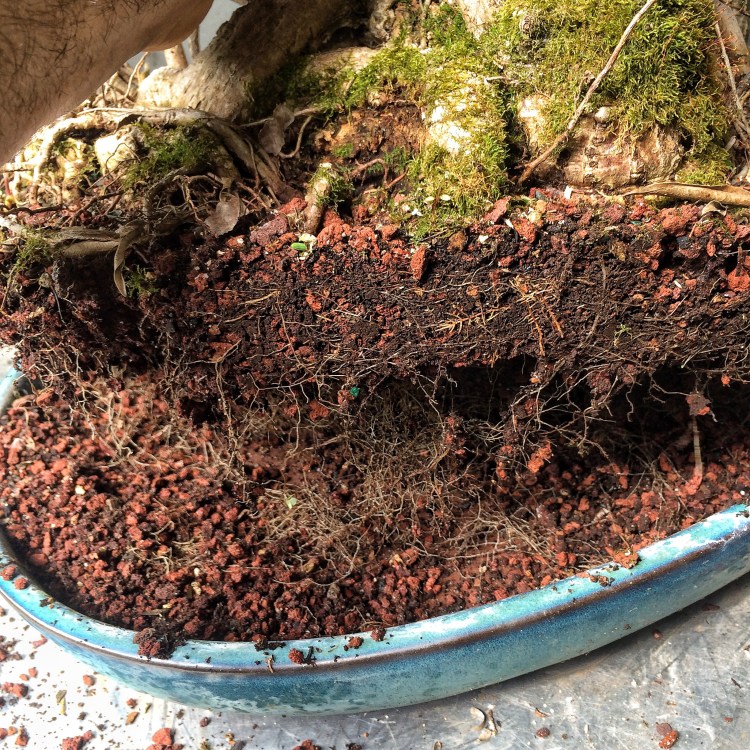
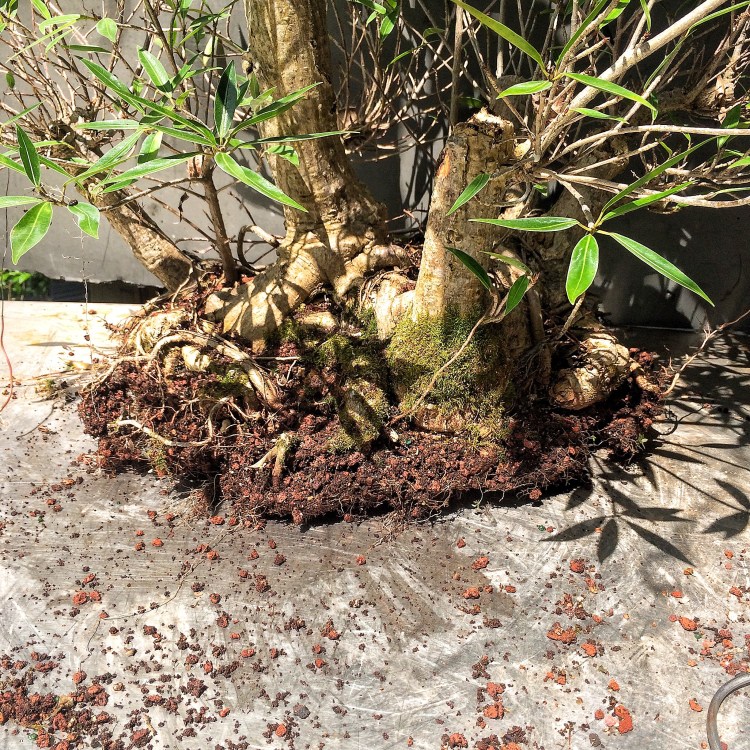
The roots need some work: Delving back in time before the tree was purchased from the original grower (that would be Jim Smith), this clump was a part of (probably) a large, single trunked specimen. 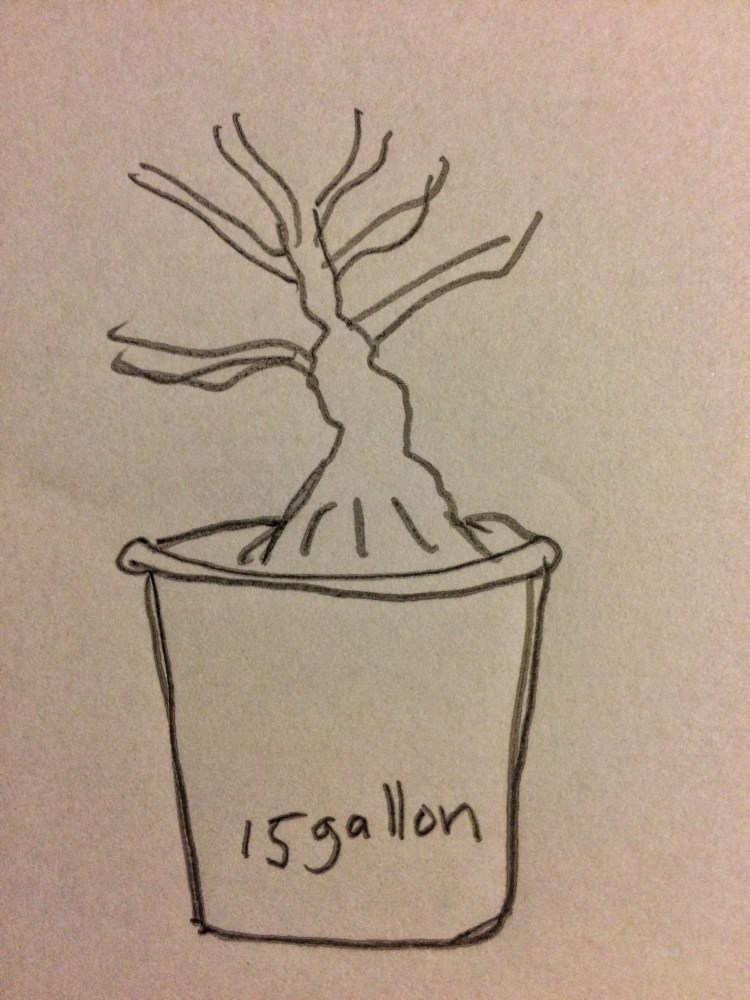
The way we deal with the roots on big ficus in growing pots (sometimes they are all roots with little soil left) is to break out the saw. 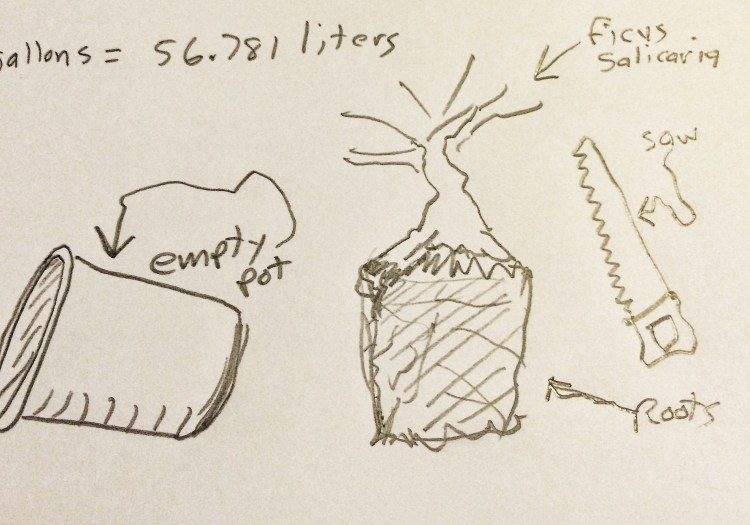
Then we cut the root ball to fit. How much? Enough to go into a bonsai pot (at this point, the trees trunk should be developed to the size you want. Don’t put a stick in a pot, that needs to grow, into a bonsai pot). 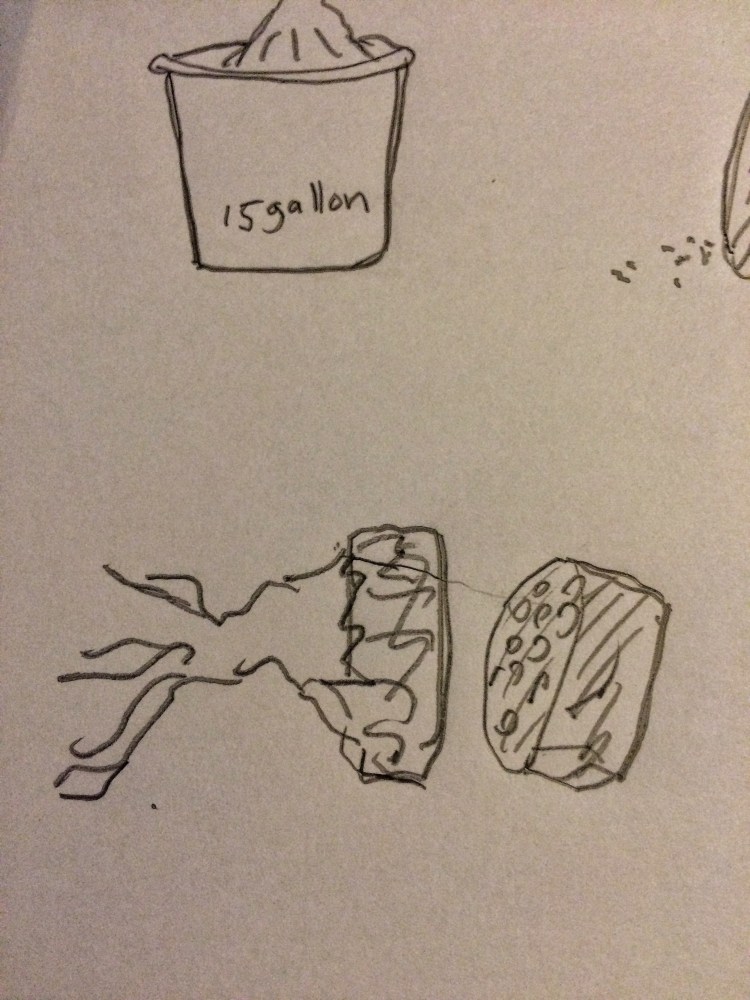
Then, after potting your specimen, instead of throwing away the bottom half of your rootball, stick it back into the old, 15 gallon nursery can. 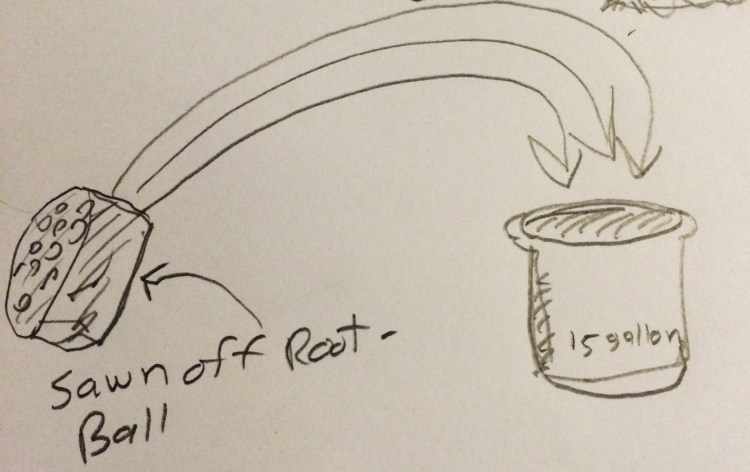
For those who are metrically predisposed, 15 gallons would be…. 
Then you wait for it to grow. 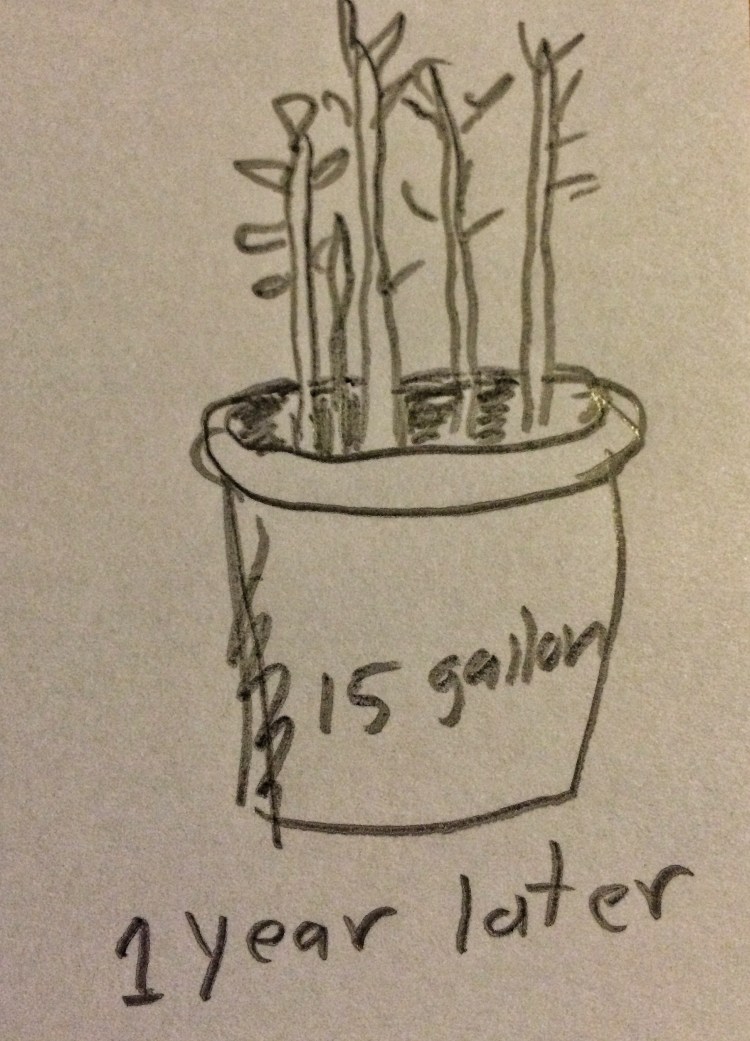 It could take a while for new shoots to appear, it could happen in a week. Let it be. This is one of those times when you want nature to do your pruning for you.
It could take a while for new shoots to appear, it could happen in a week. Let it be. This is one of those times when you want nature to do your pruning for you.
The original advice the discoverer of this technique gave was to withhold water. I find that it doesn’t matter because, you know, rain.
The originator I keep referring to is Jim Van Landingham who, at the time, was working at Durostone Nursery (that would be Jim Smith’s). Jim V noticed that the stumps they were throwing on the burn pile were sprouting. Being a child of the depression (don’t waste anything) and a pretty clever guy, Jim V said,
“AHA!
Or something like that, and the clump-style salicaria sawn-off root ball technique was born. Thankee sir!
So it’s entirely possible that this clump could have been the bottom of one of those world class trees on display at the Jim Smith Collection at Heathcote Gardens down in Ft. Pierce, Fl.
Entirely possible. Probable? Nah.
And that’s why the roots are as tangled as they are.
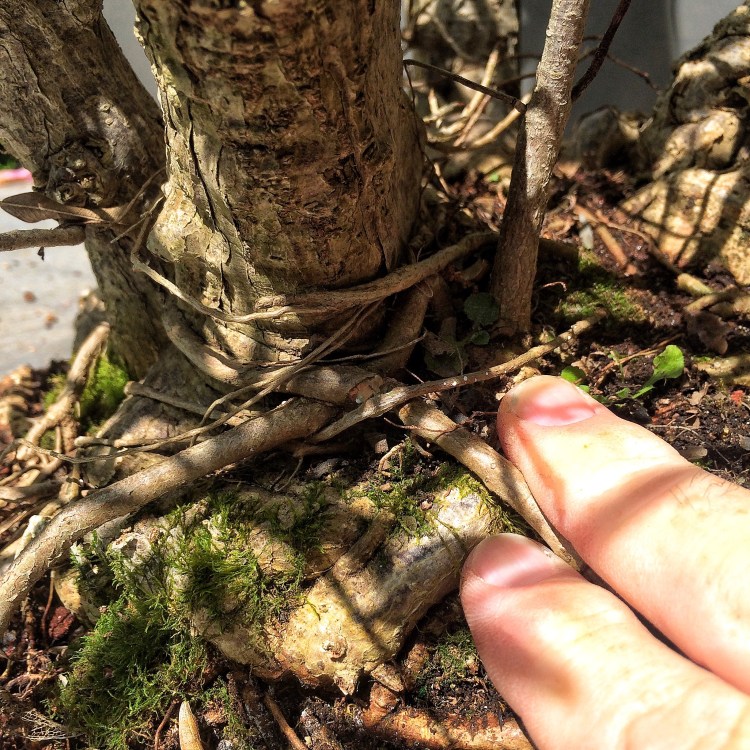
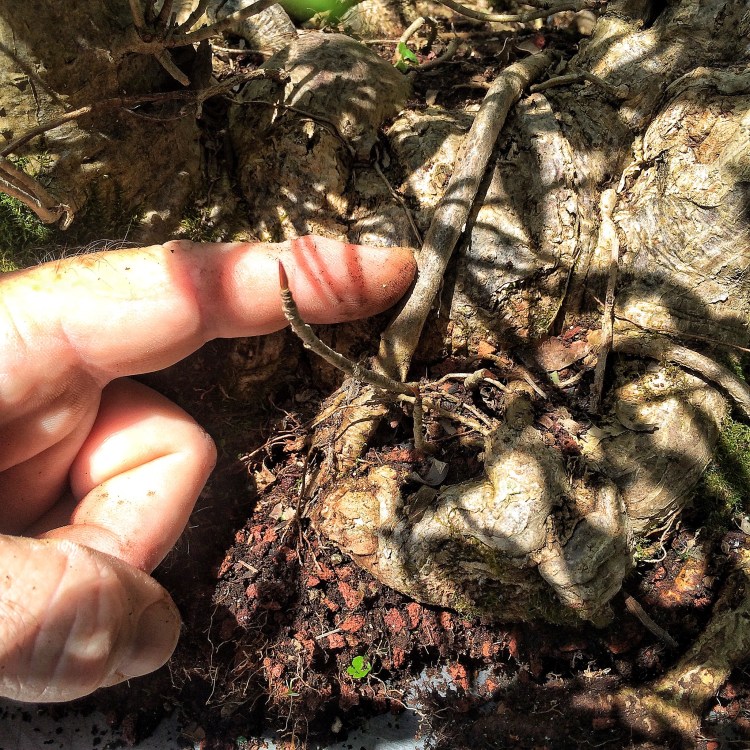
Time to turn up the music and get to work.
This song seems should rouse the spirit:
Gets the blood going, right? To work!
That’s an oddly configured root. 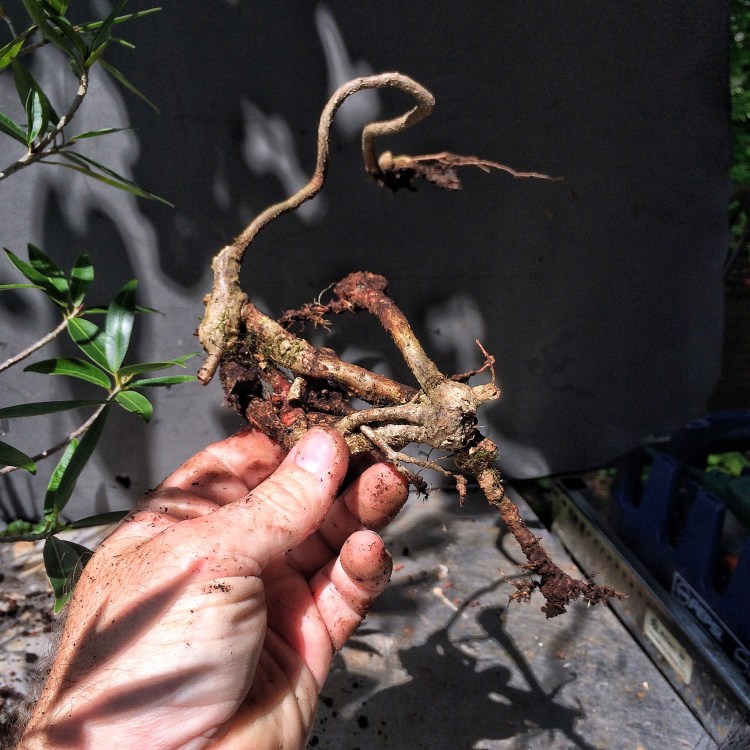
Getting there. 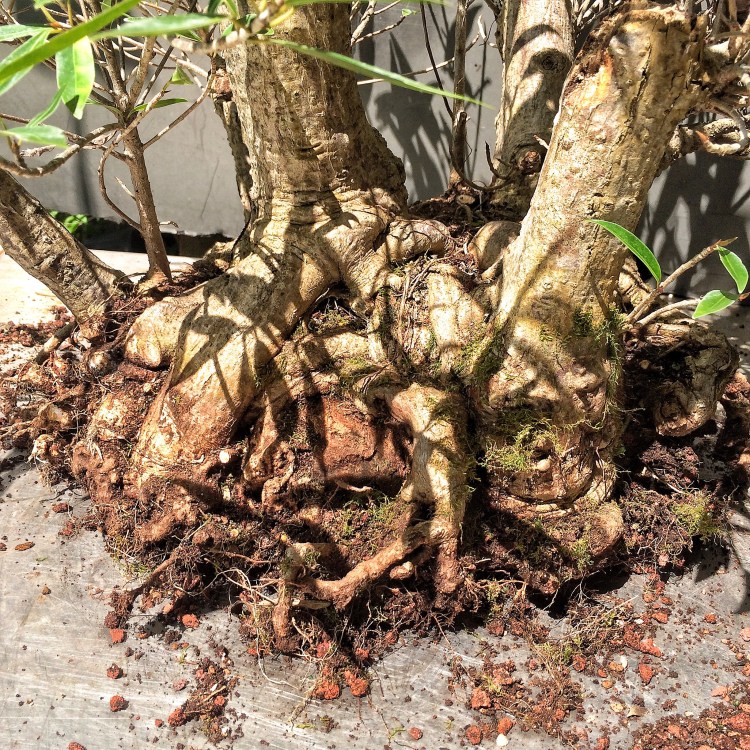
Yeah, I think that’s as good as it gets. 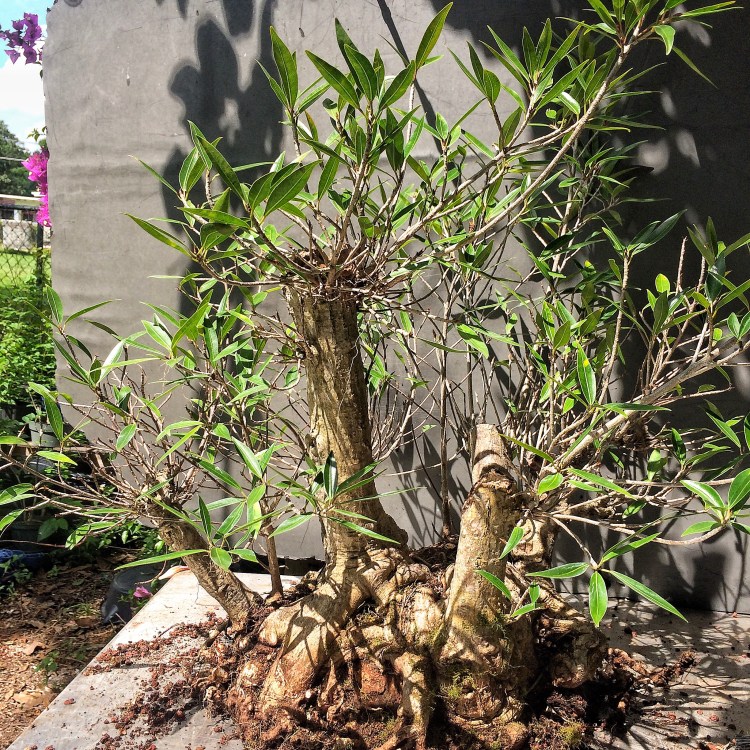
In the pot. 
And a little fertilizer.  No, that’s not too much. It won’t burn, the analysis is 5-2-1.2 with 4% iron. I use a fertilizer called Milorganite. It is organically derived. Of course I don’t leave it piled on top like that, I chopstick it in. (There have been people of late who have been putting their organic fertilizers into teabags and placing them on the top of the soil. Besides controlling the growth with lower nitrogen levels, the main point of organic fertilizers is to build the soil up with all the beneficial micro-organisms, like mychorizae, that are essential for healthy, growth. If you don’t put that fertilizer in the soil, there’s no place for those organisms to live, especially in our mostly inorganic soil mixes. Food for thought…).
No, that’s not too much. It won’t burn, the analysis is 5-2-1.2 with 4% iron. I use a fertilizer called Milorganite. It is organically derived. Of course I don’t leave it piled on top like that, I chopstick it in. (There have been people of late who have been putting their organic fertilizers into teabags and placing them on the top of the soil. Besides controlling the growth with lower nitrogen levels, the main point of organic fertilizers is to build the soil up with all the beneficial micro-organisms, like mychorizae, that are essential for healthy, growth. If you don’t put that fertilizer in the soil, there’s no place for those organisms to live, especially in our mostly inorganic soil mixes. Food for thought…).
Now….. for the haircut.
Looks like me after about six months after my bi-annual shearing. 

Some minor thinning out…. 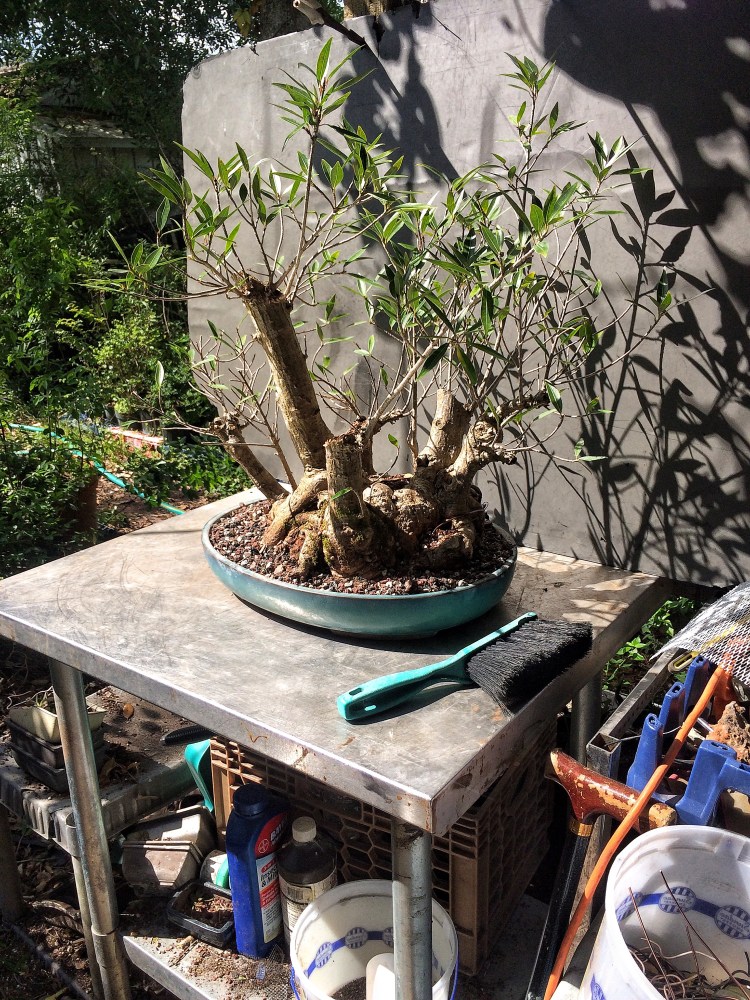
I dress the chop sites. 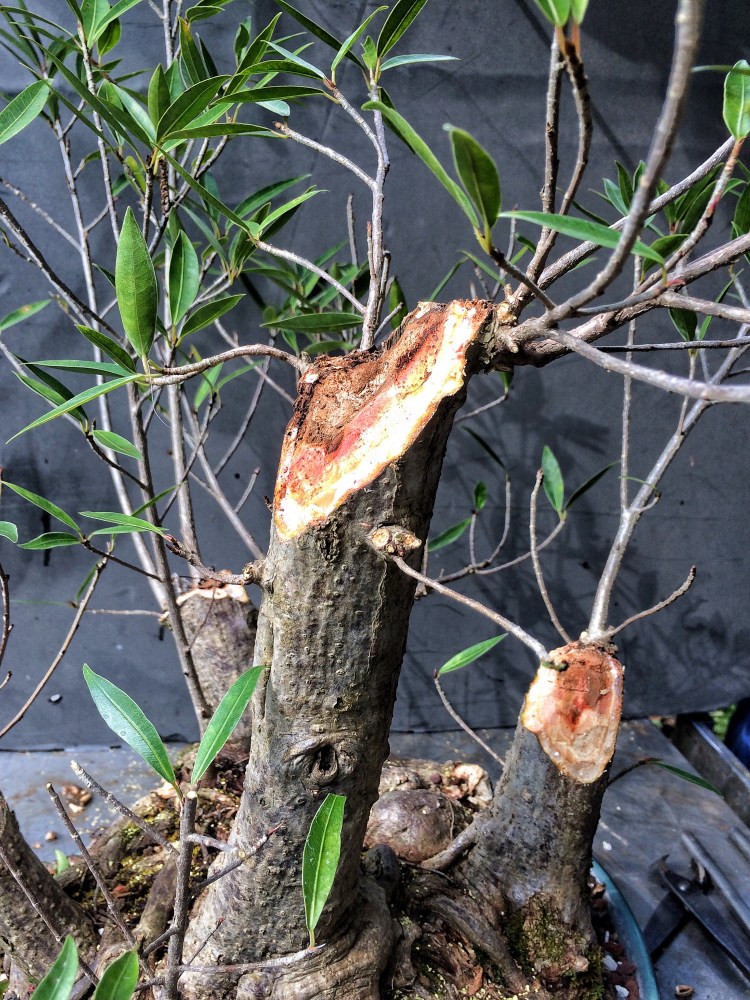 I’ll probably carve out the stumps at a later date. I haven’t decided if I want that look yet but, knowing myself, I’ll probably do it.
I’ll probably carve out the stumps at a later date. I haven’t decided if I want that look yet but, knowing myself, I’ll probably do it.
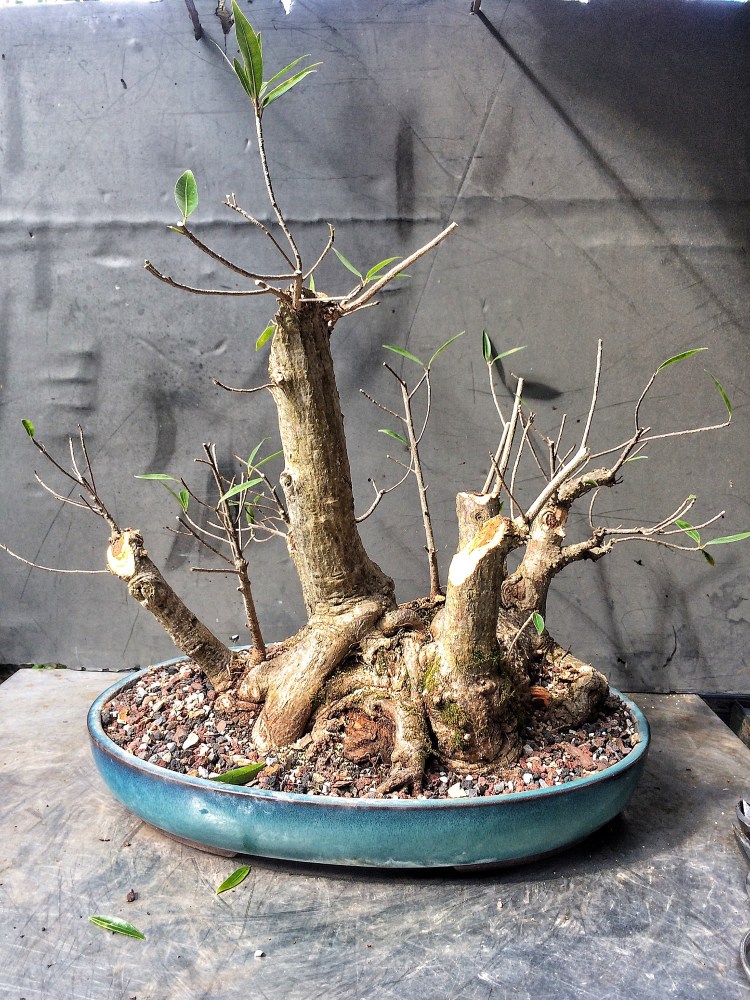 Now for some wire.
Now for some wire.
I once had a “discussion” with one of those perpetual intermediates about the possibility of styling a tree to make it look young. Like a sapling.
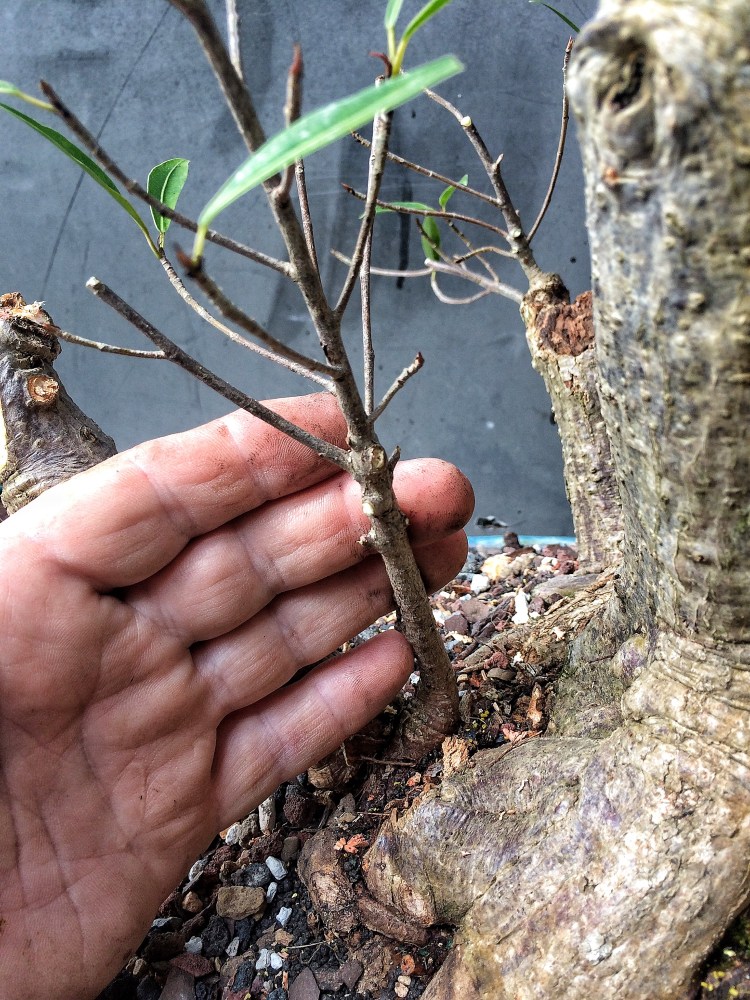 She insisted that all bonsai needed to look old (I could’ve been catty and said, “oh, like you” but I didn’t.). She was truly offended. I did manage to quiet her when I said that, in a forest planting, there are, if you want it to look natural, trees that should look young.
She insisted that all bonsai needed to look old (I could’ve been catty and said, “oh, like you” but I didn’t.). She was truly offended. I did manage to quiet her when I said that, in a forest planting, there are, if you want it to look natural, trees that should look young.
The same could be said for clumps. After some wire. 
I trimmed most of the growing tips, except for the leader.  I’ll let that one grow as tall as I can to thicken it.
I’ll let that one grow as tall as I can to thicken it.
And that, as they say, is that.
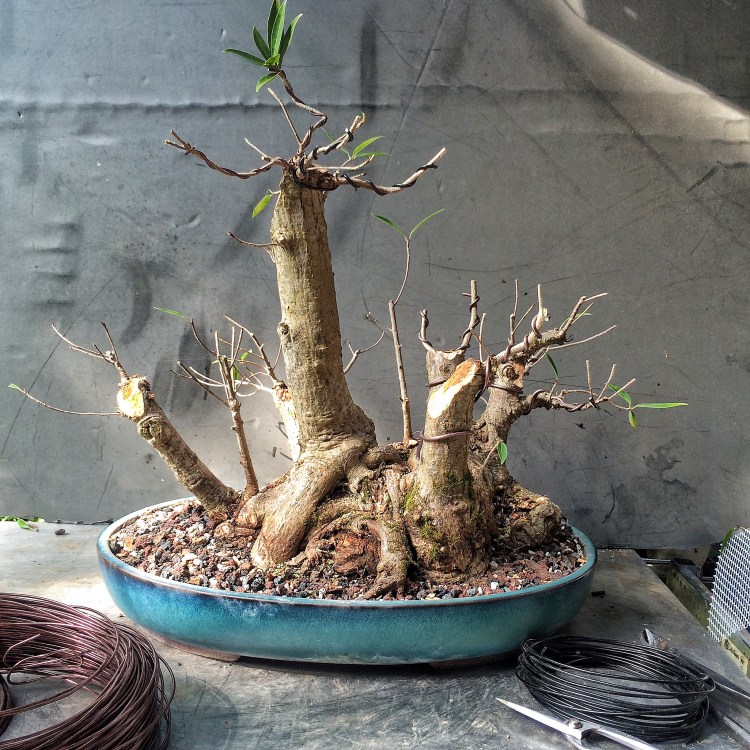 …….
…….
………….
……….
…………………….OK…..
Dammit, that trunk on the left is bugging me terribly.
It’s got to go!
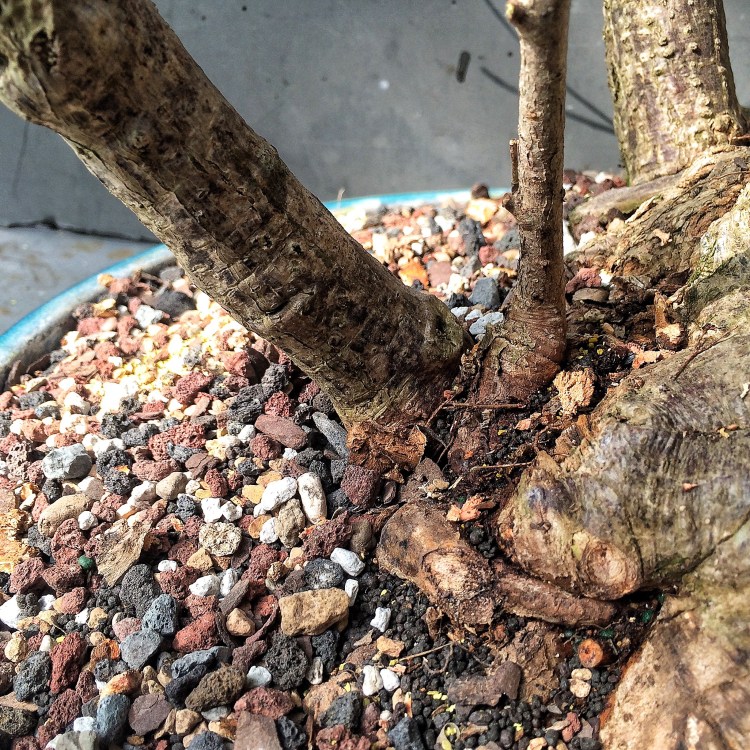
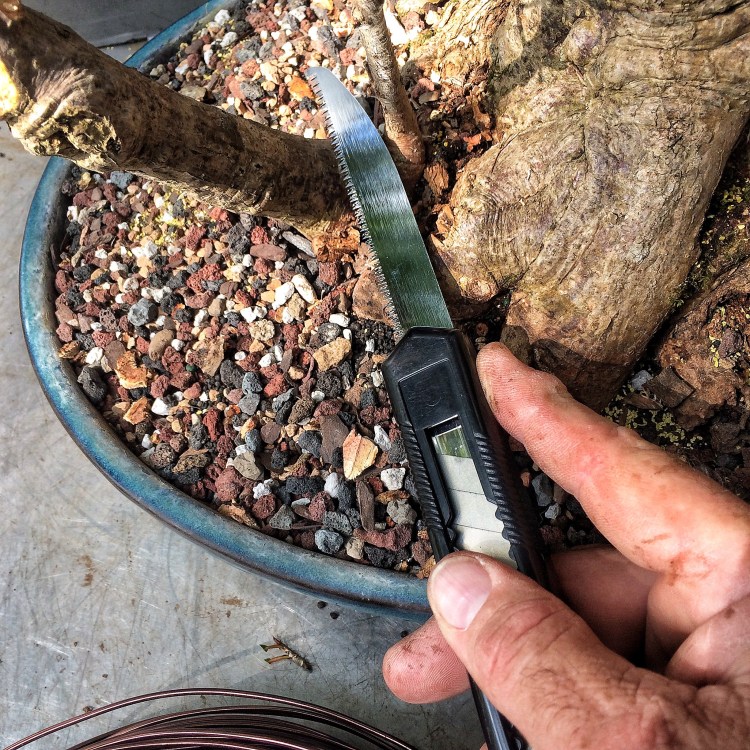
This isn’t even a good cutting. 
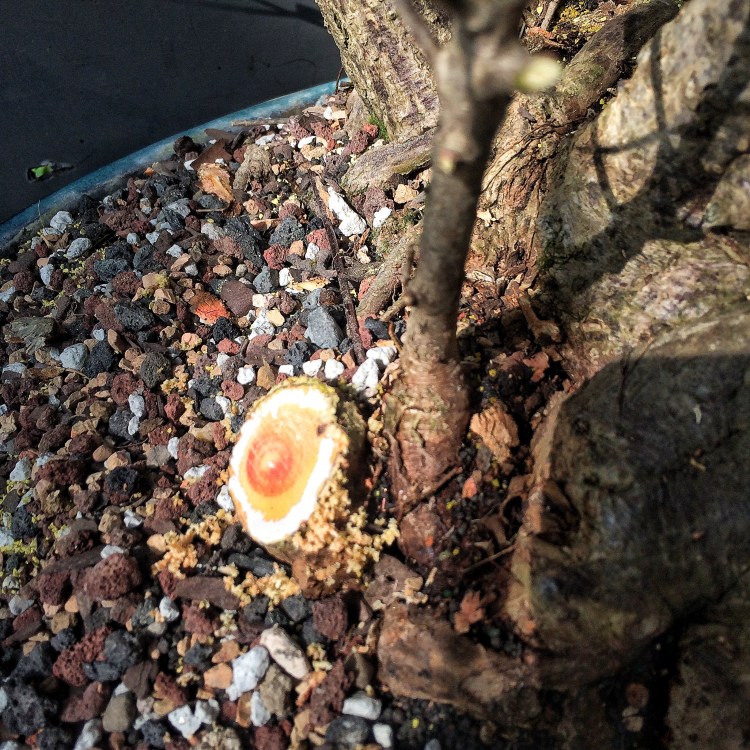 I left a stub so I can get two or more shoots, and therefore, more trunks to work with later. And those straight, skinny twigs are bugging me too. I must (I must!) add just a little more wire and…….
I left a stub so I can get two or more shoots, and therefore, more trunks to work with later. And those straight, skinny twigs are bugging me too. I must (I must!) add just a little more wire and…….
 ahhhhh….so much better. It just needs a few more years of growth.
ahhhhh….so much better. It just needs a few more years of growth.
And in case anyone was counting (and I know there are many who are) there are 7 trunks in this clump now. Are you happy, you trunk counter-ers.
I guess I should explain the unfortunate obsession some bonsai people have with counting the trees in a forest or clump planting.
Odd numbers are preferable, except the number 9 (which, in Japanese, sounds like the word for suffering).
I’ve heard many reasons for this predilection for odd numbers (I’ve actually heard some say that “even” numbers are considered unlucky. It’s actually the reverse in Asian cultures). The real reason is simple. The human brain has a preference for (visually that is) odd numbers. It’s more aesthetically pleasing. They use this in landscape design, graphic design etc.
No one really knows why, but the theories abound. It probably has to do with the mind’s need to fixate on objects and separate them; and an odd number of things let’s you do this easier than an even number, which your eye (mind) tends to see as a whole unit.
I once had a forest with one hundred and six trees on display. Some dude stood in front of them and counted them. It took him 45 minutes (he kept messing up and would have to start over. I eventually allowed him to mark each trunk with a piece of chalk). He really held up the line but, man, was he happy at the end. He did a jig and called me a ” gosh darned fraud” right in front of everyone, and God.
That didn’t really happen to me, but I’m sure it has.
I tell you, it’s a mania. An obsession. An illness. Please, stop counting trees my friends, if not for yourself, but for the children of the world. They are our future.
Speaking of future, here’s another salicaria that I teased the social media crowd with last week. I called it a boring tree: 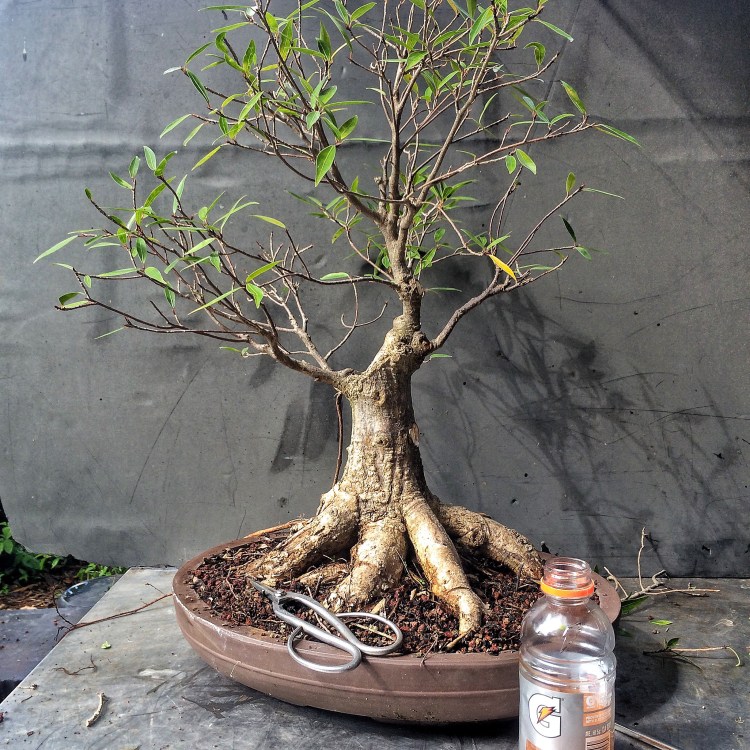
I defoliated it, cut off a root, and repotted it. Adjusted the front a little. 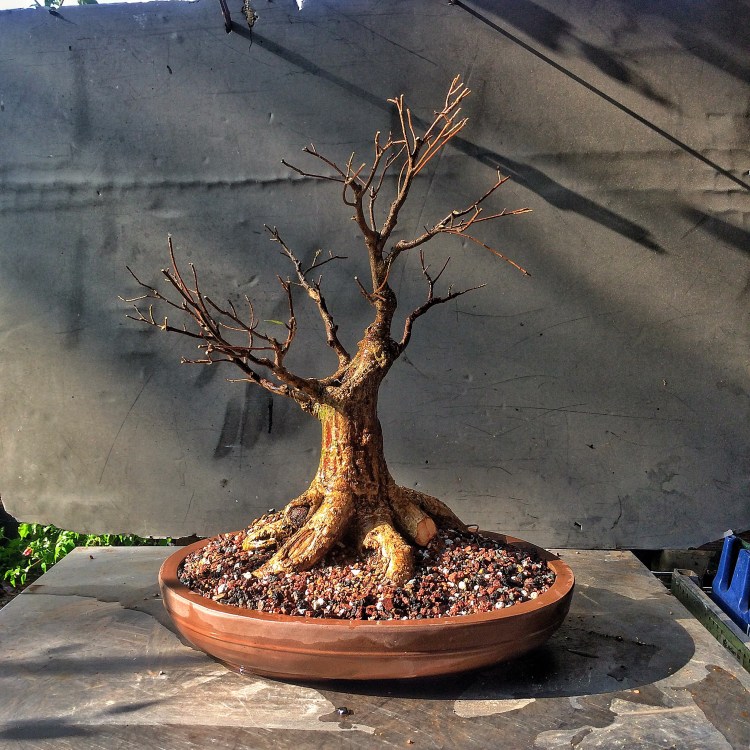 Trimmed it. And put all kinds of wire on it.
Trimmed it. And put all kinds of wire on it.  It’s still kinda boring but it’ll do. A solid, upright deciduous tree style.
It’s still kinda boring but it’ll do. A solid, upright deciduous tree style.
Now, that little microcarpa to the left. That’s an exciting tree right there…..
You have such great vision!
LikeLike
I seriously love trees going from “start” to wired. Your wiring is unparalleled! I heard you were coming back to OH and was disappointed that things hadn’t been arranged for you to be in my area. I’d love to sit down for an hour and wire twigs with you (or bonsai!). Maybe I’ll try to see if I can make it happen in the future. Anyway, glad to see you posting!
LikeLike
I’ve been holding back a little on adding dates to my Ohio trip although I did exchange emails with John Porterfield (I’m remembering you in Dayton?). I could make a side trip to you if you’d like. Send me an email (adamaskwhy@yahoo.com)
LikeLike
It might be just as easy to come down to where you are when you’re in cincinnati. I work in Dayton, but actually live in N. Cincy. You’ll be coming by at a time when my schedule is pretty flexible, so something can be figured out. What are you doing in between the Thursday Cincy meeting and the Saturday workshop?
LikeLike
Reblogged this on Wolf's Birding and Bonsai Blog.
LikeLike
A question from Australia. Do you (or does anyone) reuse wire?
LikeLike
I do with aluminum wire. You can straighten it pretty easy.
LikeLike
Thanks Adam. BTW your ‘why I waste my time’ post was one of the best pieces of writing about bonsai I have written.
LikeLike
N-P-K on the Milorganite: 5-2-1.2. I cannot find this anywhere. I only see the 5-2-0 w/ 4% iron. Where can I find this? Awesome blog, by the way.
LikeLike
I got this bag at Home Depot. Usually I get it from Walmart
LikeLike
All I see on HD, Lowes and BWI is MILORGANITE 5.2.0. No 5-2-1.2
LikeLike